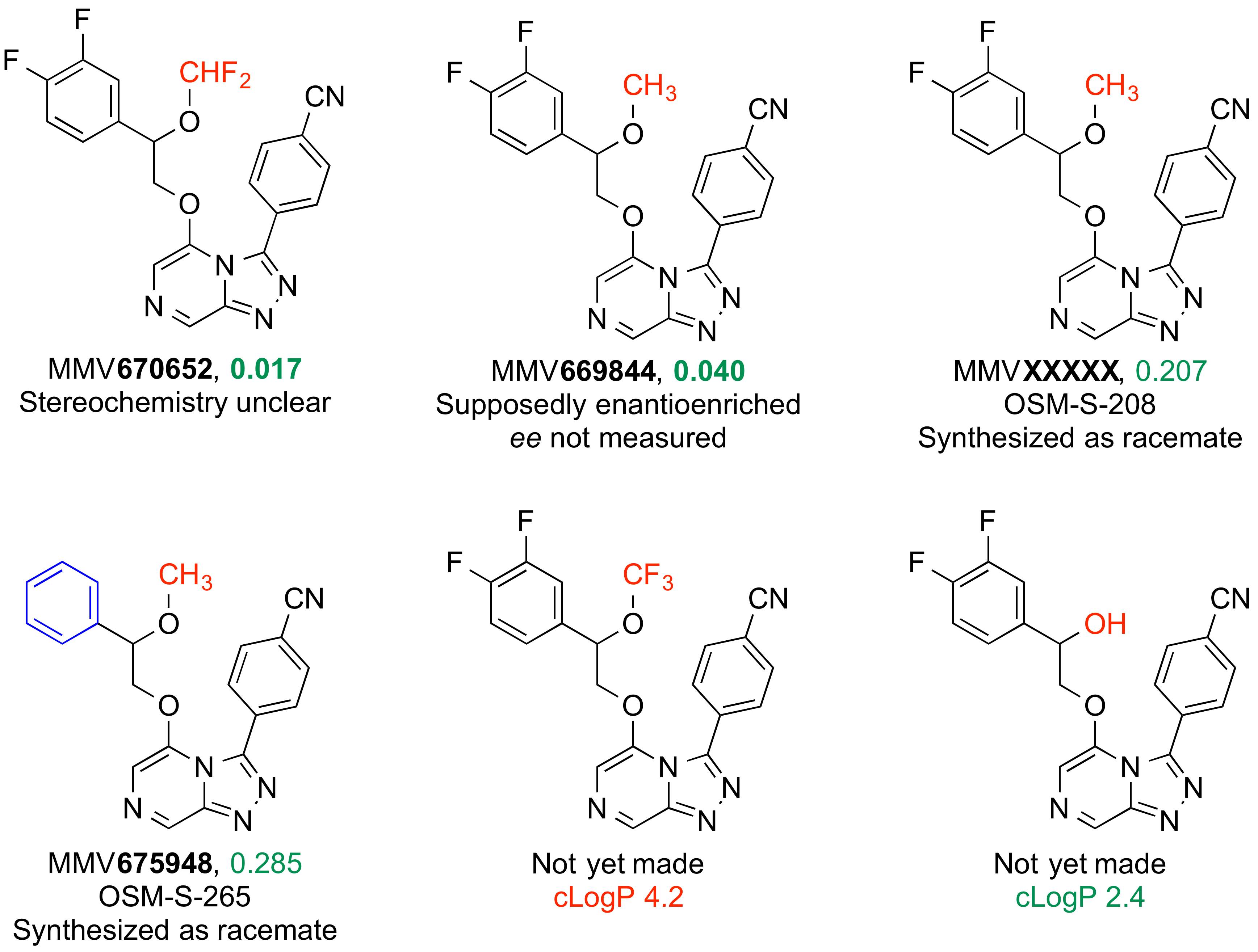Chirality Stereogenic Centres in This Series
Racemates/Resolutions:
Frontrunner compound MMV670652 was evaluated/inherited as a racemate. There was interest in separating the enantiomers (GHI115, GHI111, GHI120. However, the difluoromethyl group makes the compound slightly challenging to synthesize (GHI119 and blog post). It is not clear that this group is needed - there are related structures that could be tried, and compounds lacking this group (and indeed the whole stereogenic centre) are still active as shown in the scheme. MMV669844 (containing CH3 rather than CHF2) was an inherited compound, and was reportedly synthesized using a Sharpless epoxidation on the precursor styrene, but there are no data on the enantiomeric excess of the product - it is shown as a single enantiomer in the original briefing document, so it is presumed (only) that the sample possessed an ee. Compound OSM-S-208 (GHI166), identical to MMV669844 save that it was synthesized as a racemate, was found to be reasonably potent and can therefore be used as a surrogate for MMV670652 for the separation of enantiomers in this series (GHI111). (Note there is ongoing discussion about whether compounds differing in ee, including where the ee is not known, should have different codes (GHI172)).
Alternatives: The CF3-substituted compound shown has yet to be made but has a prohibitively high cLogP; however the hydroxyl-substituted compound remains of interest (GHI178) and the des-F analog is under investigation (GHI235). MMV675948 (OSM-S-265) was found to be reasonably potent, providing another simple analog suitable for enantiomer separation. GHI236). Methoxy-substitured ether analogs lacking the Ph in the side chain are under investigation (GHI238, GHI239) though the only related inherited analog (MMV670762) is inactive.
Generally speaking all inherited compounds should be treated as racemates unless there is reason not to.
One approach to the synthesis of the chiral alcohol fragment needed for the racemic samples (e.g. of MMV670652) requires a source of cyanide.
Another approach to enantioenriched compounds in this series is through benzylic amines, either the known compounds MMV670437, MMV670763 and MMV671651 or analogs thereof (see GHI242, GHI241 and GHI240 respectively. (All three inherited amines were supposedly enantioenriched).
Enantioselective approaches have been proposed to access enantiopure/enriched compounds with a chiral centre at the benzylic position in compounds where there is a phenylethylether on the LHS.
One proposed route for where this substituent is an alcohol arm, suggested an enantioselective approach to the benzylic-functionalized ether compounds (GHI#167).

Another proposal towards tertiary alcohols involved the catalytic enantioselective desymmetrising benzoylation of meso-2-substituted glycerols - the intermediates used in the synthesis of the OHOH compounds. Two papers show how chiral tertiary alcohols can be formed in this way with high enantioselectivity - one using a bisoxazoline-copper complex and the other an imine copper chloride complex (GHI#Series4/58).

Aims, Concerns and Current Interest in Series 4
Modification of Core Triazolopyrazine
Modification of Pyrazine Substitution Pattern
Modification of the Triazole Substitution
Pyrazine Side Chain Modifications - Ethers
Pyrazine Side Chain Modifications - Amides
Pyrazine Side Chain Modifications - Reversed Amides
Pyrazine Side Chain Modifications - Others
Biological Data Currently not Incorporated into the Main Wiki Sections
Mechanism of Action: Possible PfATP4 Activity Deduced from Parasite Ion Regulation Assays
Synthesis of the Ether-Linked Series
Synthesis of the Amide-Linked Series
Synthesis of the Reverse Amide- Linked Series
Synthesis of Benzylic Functionalised Ether-Linked Series
Alternative Routes to the Triazolopyrazine Core
Triazolopyrazine telesubstitution
Chirality/Stereogenic Centres in This Series
Other Sources of Compounds Relevant to this Series
Desirable Compounds Not Yet Synthesised

